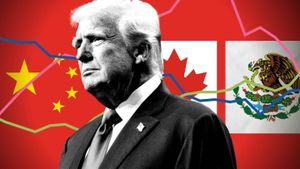On February 1, 2025, the United States will implement tariffs on imports from Mexico and Canada at 25%, alongside 10% tariffs on imports from China, reaffirmed during a recent press conference by U.S. presidential spokesperson Levitt.
These tariffs are not only set to be immediate but represent the administration's continued stance on addressing issues believed to stem from illegal immigration and synthetic drugs flowing from its southern neighbors. Levitt emphasized this point, stating, "We will implement the 25% tariffs on goods from Mexico and Canada on February 1," underscoring the administration's resolve.
The official announcement clarifies confusion surrounding previous reports which suggested the tariffs may be postponed until March 1. Levitt explicitly rejected those claims, labeling them as "incorrect" and confirmed, "The reports about the tariffs being postponed to March 1 are incorrect." This statement serves to bolster the firm direction the U.S. is taking with its tariff policies.
Canadian Prime Minister Justin Trudeau responded to the impending tariffs, indicating readiness to respond effectively and swiftly. He stated, "We are prepared to take strong, reasonable, and swift action," signaling potential retaliatory measures, which could complicate North American trade relations.
Meanwhile, Mexican President Shea Bauman adopted a more measured approach, expressing openness to continue dialogue and negotiation. He commented, "We intend to continue calm dialogue," indicating hopes for de-escalation rather than confrontation.
This new round of tariffs enters against the backdrop of longstanding trade discussions and negotiations under previous administrations. It also highlights the U.S. government's increasing focus on immigration-related issues, making trade policy increasingly intertwined with broader socio-economic factors.
The tariffs come with no mention of potential exemptions or special conditions, leaving many stakeholders awaiting details on which items will be affected. Levitt avoided questions on exemptions, stating, "There are no updates or explanations about exemptions."
With these tariffs set to take effect, it is expected there will be significant ramifications for businesses operating within these trade dynamics. Companies may face increased costs leading to higher prices for consumers, particularly for goods imported from these regions.
Analysts are now watching closely how Canada and Mexico may respond to the U.S. tariffs. While Trudeau has signaled readiness for strong action, it remains unclear what options might be on the table. Potential measures could include retaliatory tariffs or seeking recourse through international trade bodies such as the World Trade Organization.
This import tariff strategy not only showcases the Trump administration's aggressive trade posture but also its focus on national security arguments, attempting to link trade policy directly to border and immigration matters.
Critics of the tariffs argue this may lead to spiraling trade tensions and hinder economic recovery efforts. Some economic analysts assert retaliatory measures could negate any benefit derived from these tariffs, potentially harming U.S. economic interests more than helping them.
Political experts highlight the potential for these tariffs to influence the upcoming electoral climate as they assess how various stakeholders perceive these actions. Are American manufacturers likely to rally behind the administration or voice concern over retaliatory measures impacting their operations?
Further complicity arises from the North American Free Trade Agreement's recent revisions, which sought to create smoother trade dynamics within the region. These new tariffs pose questions about the future stability of this trading bloc and cooperative framework.
While details emerged slowly, businesses and local markets continue to adjust to this new reality as February 1 approaches. There’s speculation about how long these tariffs may remain and whether future administrations will embrace these measures or seek to reverse them.
Consequently, the path forward remains uncertain as stakeholders await clarity on trade policy and the potential economic ripple effects. The administration's commitment to these tariffs seems firm, but the broader impacts of such decisions are bound to shape U.S. foreign policy and economic relations for years to come.



